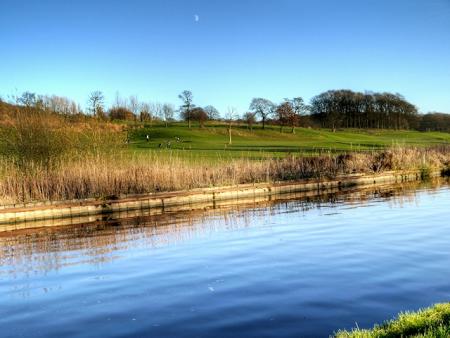
Area characterisation:
Biogeographic region: Atlantic (River Aire Catchment Area Leeds)
Surface area: 97 ha (Water Haig Woodland Park)
Country: England, UK
Region/Province: Yorkshire / City of Leeds
Following many years of coal mining along the valley of the River Aire to the south-east of the City of Leeds, large-scale landscape restoration began in the mid 1970’s. This has resulted in the Lower Aire Valley emerging as a regionally important example of a multi-functional, landscape scale habitat creation.
Now part of the White Rose Community Forest, it combines a mosaic of new UF-NbS (Urban Forests as Nature-Based Solutions) with extensively restored wetland habitats, allowing connectivity for wildlife and providing full public access and opportunities for improved health and wellbeing. The Case Study looks specifically at the Water Haig Woodland Park, an area of over 97 ha, that comprises over 30 ha of peri-urban woodland, and is one of three UF-NbS orientated parks that straddle the River Aire as part of Naturalised Flood Management.
Although many organisations have been involved in restoring this area, it is now owned and managed by Leeds City Council.
Objective:
The case study site provides connected multi-functional green space that maximises ecosystem services for the sites and the local communities. Objectives include:
- The provision of regionally important landscape scale natural habitats, encompassing mixed woodlands, hedgerows, grasslands and wetlands, encompassing the reclamation of UF-NbS (Urban Forests as Nature-Based Solutions) of previously mined industrial land.
- The provision of unlimited public access via footpaths, cycle ways and bridle ways;
- The health and well-being benefits enjoyed both by the local communities and other visitors.
Financing:
Community fundraising:
The Community Group called The Friends of the Water Haigh Woodland Park hold occasional fund-raising events to supplement the funding from Leeds City Council. Funding for the management of urban/peri-urban green space in the UK has been significantly reduced over recent years, so local communities can play a crucial role in supplementing local authority funding.
City, regional general funds:
Some funding from Leeds City Council, and in the past from the EU Regional Development Fund.
Special funds e.g. National Lottery, Challenge funds:
The White Rose Community Forest receives grant funding from a number of sources, and thus funds new tree planting and prospective management in and around the case study site.
International funds:
Funds have been available in the past from the EU Regional Development Fund, but this will cease once the UK has left the EU.
Actions:
PRINCIPLE UF-NbS (Urban Forests as Nature-Based Solutions) ACTION(S)
- Provision of connected multi-functional green and blue infrastructure that maximises ecosystem services
- Peri-Urban Woodland plantations that contribute to the White Rose Community Forest and the Northern Forest Project
- The planting of hedgerows, grasslands and wetlands to assist connectivity
- A water retention basin to protect local residential communities from flooding
- An annual tree planting programme
OTHER PRINCIPLE NbS ACTION(S) – non-UF
- Over 14.5 km of Public Rights of Way, plus an extensive network of permissive paths which allow walkers, cyclists and horse riders to explore the whole valley.
- The setting up of the Friends of Water Haigh Woodland Park, who organise a wide range of activities and events for local communities, and are involved in management decisions.
Lessons learnt:
The success of the green and blue infrastructure work that has been carried out along the Lower Valley of the River Aire in Leeds has significantly influenced the adoption of UF-NbS by Leeds City Council as its prime means of established quality green space in and around the city, especially not ‘over designing’ the schemes.
This has also resulted in the acceptance that ‘community consultation’ is all too often seen as ‘top down’ and that ‘community engagement’ provides a far better ownership of the schemes by the community. These benefits are now being recognised and accepted across the whole Leeds City Region.
Organisations:
1. Governing authorities: The Leeds City Council; West Yorkshire Combined Authority; Yorkshire West Local Nature Partnership.
2. Associations: The White Rose Community Forest; Yorkshire Wildlife Trust; Royal Society for the preservation of Birds; the Friends of Water Haigh Woodland
3. Citizens: Volunteers from the Friends of Water Haigh Woodland Park; Educational establishments who provide organised groups of school children.
4. Municipalities: Council Wards of Garforth and Swillington; Kippax and Methley; Rothwell. Allerton Bywater Parish Council.
5. Public/private institutions: Public institutions: City Planning, Urban Design, Urban Forestry and Landscape Officers; Leeds Beckett University; Leeds University; Office of Urban Planning;
6. Park planner and authorities: Leeds City Council Departments of Planning / Design, Highways, Health and Social Care; Finance; Environmental Management.
7. Technicians for park maintenance/monitoring and to educate and support citizens: Leeds City Council Department of Environmental Management.
Contacts:
Glenn Gorner MICFor.
Natural Environment Manager
Leeds City Council, Leeds, UK.
Tel: + 44(0)113 3786002
E-Mail: Glen.Gorner@leeds.gov.uk
Global goals:
-
3. Good Health and well being
-
11. Sustainable cities and communities
NBS goals:
- Enhancing sustainable urbanization
- Restoring ecosystems and their functions
- Urban regeneration through nature-based solutions
- Nature-based solutions for improving well-being in urban areas
NBS benefits:
- Increase infiltration / Water storage
- Improve connectivity and functionality of green and blue infrastructures
- Increase accessibility to green open spaces
Further information:
The compilation of this case study description has been funded by the Horizon 2020 CLEARING HOUSE project. This project has received funding from the European Union’s Horizon 2020 research and innovation programme under grant agreement No 821242.